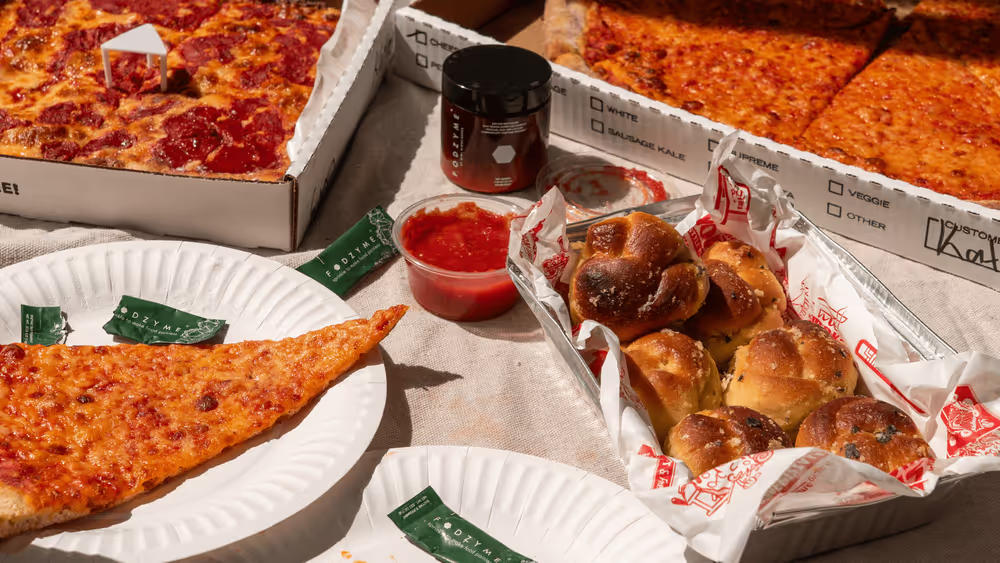If you're following the low FODMAP diet for irritable bowel syndrome (IBS) management, you may be wondering whether you can still include pizza in your eating plan. While many traditional pizza ingredients contain FODMAPs, you'll be happy to know that it's still possible to create a delicious low FODMAP pizza!
This article will guide you through which ingredients you can use to make the crust and low FODMAP pizza sauce, as well as which low FODMAP toppings you can enjoy. We'll also provide tips for ordering a low FODMAP pizza at a restaurant so you can navigate low FODMAP fast food with ease.
What You Need to Make a Low FODMAP Pizza
We get it — following the low FODMAP diet can be hard, and it often feels like there are limited foods you can actually eat. However, with just a little extra effort and planning, you can enjoy pizza without the bloat and other digestive symptoms.
Here's a breakdown of the ingredients you'll need to create the perfect homemade low FODMAP pizza.
Crust
When it comes to low FODMAP pizza crust, you have two options: starting with a pre-made, frozen pizza crust or creating your own pizza dough from scratch. If you're short on time, a frozen pizza base can be a great time-saver, but if you have a bit more time on your hands, nothing compares to a homemade pizza crust!
If you're making your own pizza crust from scratch, use a gluten-free pizza flour, such as Bob's Red Mill Gluten-Free Pizza Crust Mix (which yields two pizzas) or King Arthur Baking Company's Gluten-Free Bread & Pizza Mix. These flour blends are specifically made to create the perfect pizza crust at home. While it's the fructans in wheat-based products that typically cause intolerance and sensitivity in people with IBS (not gluten), most gluten-free flour blends are also low in fructans. Just be sure to check that they don't contain high FODMAP ingredients like chicory root fiber.
Alternatively, you could make a homemade sourdough crust using regular wheat flour. When you make sourdough, you typically let it rest for at least 12 hours. During this time, the yeast breaks down the fructans in the wheat flour, making it easier for many people with IBS to tolerate.
If you prefer a premade pizza crust, Schär gluten-free pizza crusts are a fantastic option. Each package contains two individually wrapped crusts so that you can create two different types of pizza (or simply freeze the second crust for future use).

Sauce
Next comes the sauce. Traditional white pizza sauces often contain high FODMAP ingredients like garlic and milk or heavy cream, so it's generally best to stick with a traditional tomato sauce or oil.
When choosing a tomato sauce, always check the ingredients on pre-made sauces, as many pre-made pizza sauces often contain onion or garlic ingredients. Sauces like Rao's Sensitive Marinara Sauce and FODY's Tomato Basil Pasta Sauce are great options if you're looking for a quick and easy low FODMAP pizza sauce. Alternatively, use garlic-infused olive oil for all the garlic flavor without the FODMAPs.
Cheese
While many dairy products (including some cheeses) contain lactose, there are many cheese options that you can include on a low FODMAP pizza. In general, aged cheeses are lower in lactose at serving sizes of 40 grams (1.5 ounces) or less. Here are some low FODMAP cheeses to add to your pizza:
- Cheddar
- Goat
- Gruyere
- Havarti
- Manchego
- Monterey Jack
- Mozarella
- Parmesan
If you prefer a completely lactose-free cheese, brands like Bunker Hill Cheese, Daiya, and Cabot Creamery offer lactose-free options that are just as delicious as their lactose-containing counterparts.

Toppings
Finally, the most important part — the toppings! Here are 10 FODMAP-friendly topping options.
- Ham: Naturally low in FODMAPs, but choose plain ham without honey glaze, garlic, or onion seasoning.
- Pineapple: Fresh pineapple is low FODMAP at up to 1 cup, adding sweetness and balance to savory toppings like ham.
- Basil: Fresh herbs like basil are naturally low FODMAP and add a burst of freshness to your pizza.
- Oyster mushrooms: Unlike other mushroom varieties, oyster mushrooms are low FODMAP up to 1 cup.
- Green bell peppers: Low FODMAP at a ½ cup serving, green bell peppers add crunch and color to your pizza.
- Chicken: Plain grilled or roasted chicken breast is naturally low FODMAP and adds a source of lean protein.
- Jalapeños: Fresh jalapeños are low FODMAP in small amounts (1 pepper), adding heat without excess FODMAPs.
- Black olives: Low FODMAP in typical serving sizes, black olives provide saltiness that brings out the flavor of other toppings.
- Arugula: Arugula is a low FODMAP option and makes a fresh green topping.
- Sliced tomatoes: Sliced common tomatoes are low FODMAP in servings of up to half a medium tomato, adding juiciness and acidity.
For more low FODMAP information, check out the Monash FODMAP app. Researchers at Monash University have lab tested hundreds of foods to determine their FODMAP content, so you can be sure you're getting the most up-to-date information. If something hasn't been FODMAP-tested, read labels for high FODMAP ingredients, such as onion and garlic.

How to Make Your Low FODMAP Pizza
Now that you know which ingredients to use, it's time to make your low FODMAP pizza. Here's what you need to know to get the perfect pizza every time.
Step One: Prepare the Dough
If you're using a gluten-free pizza crust mix like Bob's Red Mill, preparing the dough is as simple as following the instructions on the package. While preparation methods may vary slightly between brands, you'll typically need to combine flour with warm water, eggs, olive oil, yeast (usually included in the package), and, in some cases, salt. Use a wooden spoon to thoroughly mix the ingredients.
You'll need to factor in rising time as part of the overall prep time for your low FODMAP pizza. Again, this will vary depending on the brand of pizza crust mix you use. Bob's Red Mill pizza crust mix needs to rise in a warm location for 20 minutes before rolling it into a pizza crust.
Finally, you will need to par-bake some crusts before adding the toppings. Bob's Red Mill pizza crust mix should be baked at 425oF for seven minutes before adding toppings.
Step Two: Add Sauce and Toppings
Now comes the fun part — adding the sauce and pizza toppings! For a 12-inch pizza, you'll want to add between ⅓ and ½ a cup of sauce, spread evenly across the crust. Any more than that can make the crust soggy and cause your toppings to fall off.
Next, add your pizza toppings. First, add most of the cheese directly on top of the sauce so it melts into the sauce and holds your toppings in place. Then, add meat and hearty veggies, such as ham, chicken, and peppers. Pineapple chunks can also be added here, allowing them to caramelize. Finally, add a small handful of cheese on top to hold all your pizza toppings together.

Step Three: Bake to Perfection
When it comes to baking the perfect pizza, temperature is key. Generally, you should set the oven to between 425°F and 475°F. Place a pizza stone, pizza pan, or baking sheet in the oven while it's preheating (this is a trick for getting a crispier crust).
Baking time will vary depending on your oven temperature. For Bob's Red Mill crust, which is baked at 425°F, 15 to 18 minutes is recommended. If you're using a higher temperature, such as 475°F, the baking time will be approximately 10 to 12 minutes. If you're using a frozen crust, you can place the pizza crust directly on the oven rack for a crispier crust.
If this is your first time making pizza at home, keep an eye on it for the final 5 minutes so it doesn't burn. Your pizza is finished when the cheese is bubbly and the crust is golden brown.
Step Four: Enjoy
Once you've finished baking your pizza, let it cool for 2 to 3 minutes. Add the delicate toppings such as basil and arugula, as well as optional toppings like red pepper flakes for a kick of heat. Slice into six to eight evenly sized pieces and serve alongside a low FODMAP salad for a balanced and delicious meal.
Ordering a Low FODMAP Pizza
If you don't feel like making your own low FODMAP pizza, you can also adjust your restaurant order to fit your dietary needs. Here are some tips for ordering a low FODMAP pizza at a restaurant.

Go Gluten-Free With the Crust
While it's not gluten that people with IBS need to avoid (it's the fructans found in wheat that typically cause digestive issues for people with a FODMAP intolerance), most gluten-free and traditionally-leavened sourdough crusts are also low FODMAP. Many restaurants now offer gluten-free and sourdough crusts as an alternative to the traditional wheat flour crusts, so opt for one of these to keep the crust low FODMAP.
Substitute Pizza Sauce With Olive Oil
Unfortunately, many tomato sauces found in restaurants also contain onion and garlic, which are high in FODMAPs. You have two options for the sauce. First, you can ask the restaurant if their tomato sauce is made with onion powder or garlic powder. If it's not, it's likely a low FODMAP pizza sauce.
However, if the tomato sauce is made with onion and garlic, you can ask the restaurant to substitute the tomato sauce for olive oil or fresh tomatoesl. While you won't get the traditional tomato flavors from garlic, it still provides a delicious base for a wide variety of different low FODMAP toppings.
Ask for Aged Cheeses
Next comes the cheese. Again, you have a few options here. If you're not lactose intolerant, you can add any cheese you like in the amount that feels comfortable for you. However, if you are lactose intolerant, you may need to ask the restaurant to reduce the amount of cheese to minimize the lactose you consume.
Alternatively, you can ask for low FODMAP cheeses like mozzarella, cheddar, or parmesan, which are generally relatively low in lactose.

Best Toppings to Order
Rather than ordering your pizza straight from the menu, consider ordering a "create your own" pizza with low FODMAP toppings. Here are some low FODMAP toppings you can use.
Meat
- Ham (uncured, plain)
- Grilled chicken (ensure it's not seasoned with onion or garlic)
- Turkey slices
- Prosciutto
Vegetables and Fruits
- Green bell peppers
- Zucchini
- Baby spinach
- Arugula
- Tomato slices
- Olives (black or green)
- Pineapple
- Oyster mushrooms
- Eggplant
Fresh Herbs
- Basil
- Oregano (dried oregano is also a good option)
- Parsley
- Chives
- Thyme
- Optional: Red pepper flakes
While ingredients like pepperoni and salami may appear to be low FODMAP, they're often made with onion and garlic, so it's generally best to avoid them if you're not certain they're low FODMAP.
Not sure what kind of pizza to order? Here are five tried-and-true combinations:
- Hawaiian-style: Tomato base, ham, pineapple, green bell peppers, and fresh basil.
- Mediterranean veggie: Garlic-infused olive oil base, zucchini, roasted eggplant, black olives, baby spinach, and fresh or dried oregano.
- Classic Margherita: Tomato base, fresh tomato slices, mozzarella, and fresh basil.
- Chicken and veggie: Olive oil base, grilled chicken, green bell peppers, zucchini, oyster mushrooms, spinach, and fresh or dried thyme.
- Prosciutto and greens: Tomato base, prosciutto, cherry tomatoes, arugula, fresh parsley, and fresh chives.
Perfecting Your Low FODMAP Diet
To follow the low FODMAP diet successfully, you need to know about the different FODMAP groups. There are five different FODMAP categories. Here's a list of the categories, with common foods containing each of the different FODMAPs:
- Fructans: Wheat- and rye-based products (like bread and pasta), onions, garlic, leeks (the white part).
- Galacto-oligosaccharides (GOS): Most legumes and cruciferous vegetables (such as black beans, kidney beans, and broccoli).
- Lactose: Milk, yogurt, and some cheeses.
- Excess fructose: Apples, pears, blackberries, grapes, mangoes, watermelon.
- Polyols (sorbitol and mannitol): Apples, pears, most stone fruits (like peaches and plums), prunes, watermelon.
There are two ways to follow the low FODMAP diet. The first option is a strict low FODMAP diet, which lasts for two to six weeks, replacing all high-FODMAP foods with lower-FODMAP alternatives. The second is a simplified low FODMAP diet, which replaces only the highest FODMAP foods in each FODMAP category with lower FODMAP alternatives.

In both cases, the low FODMAP diet is a temporary diet designed to get symptoms under control and then find out which foods and portion sizes trigger your symptoms.
If you'd rather not avoid high FODMAP pizza ingredients, digestive enzymes like FODZYME can help. FODZYME contains enzymes to break down lactose, GOS, and fructans, allowing you to enjoy pizza ingredients like cheese, onions, garlic, and wheat-based pizza crust with fewer digestive symptoms.
Try FODZYME today and enjoy pizza night with fewer restrictions!


 Sarah Glinski, RD
Sarah Glinski, RD